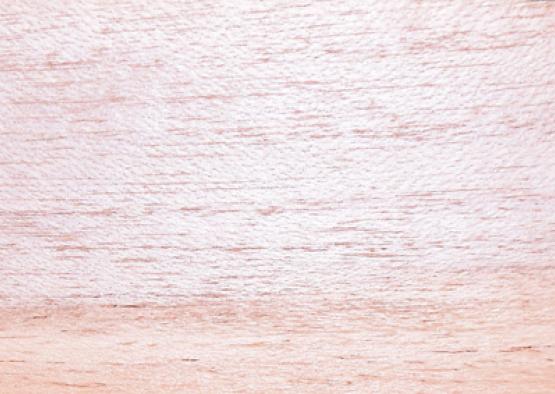Balsa wood is the lightest and softest commercial hardwood timber. White to oatmeal in colour with high silky lustre. Density 160 (120-220)kgm3, commercially preferred density range 120-160kgm3. Strength and stiffness approximately 50% that of Baltic pine (Pinus sylvestris).

Balsa is the lightest and softest timber used commercially. It exhibits an unusually high degree of buoyancy and provides very efficient insulation against heat and sound. The wood can be adapted to a great number of special end-uses where these properties are essential. The timber is white to oatmeal in colour with sometimes a pinkish tinge near the hart. Still most commercial material is from the sapwood. It has a coarse and even texture resulting from the large and infrequent sap conducting vessels. Straight grain. It is a short lived fast growing tree native to tropical South and Central America but it is widely cultivated in the tropics. Trees grow to 21m high and diameter of approximately 0.5m within seven years, reach maturity in 12-15 years after which they deteriorate with increases in density leading to the formation of hard and heavy wood and heartwood which tends to become waterlogged. Although when planted outside their natural range, the wood produced tends to be heavier and outside the commercially accepted density range for balsa the species has been planted successfully in Papua New Guinea, Malaysia, Fiji, and Indonesia.
Characteristics of balsa wood make it a unique hardwood albeit, when weight for weight basis is excluded, it is the weakest of all commercial species. The logs must be converted promptly after felling to prevent extensive splitting. Kiln drying is preferred to air-drying due to low moisture movement and very high green moisture content (200-400%). The timber works well with tools but cutting edges must be sharp to avoid crumbling and to ensure a good finish in planning. Material can be nailed, but its holding power is poor. Glues well, stains and polishes satisfactorily but it is very absorbent. Timber is prone to attack by Anobium, termites and longhorn beetle. The sapwood is permeable, heartwood resistant to impregnation. Timber cut form old trees is often brittle and decayed. Traditional uses include: surf boards, laboratory mounting boards, fish net floats, aircraft construction and model making.
Shrinkage
| Very Low | Low | Medium | High | Very High | |
|---|---|---|---|---|---|

|

|

|
|||
Tangential : |
4.90%
|
||||
Radial : |
1.80%
|
||||
Unit Movement Tangential: |
0.27%
|
||||
Unit Movement Radial: |
0.10%
|
Strength Group

Very High |
High |
Reasonably High |
Medium High |
Medium |
Reasonably Low |
Low |
Very Low |
||
Unseasoned: |
S1 |
S2 |
S3 |
S4 |
S5 |
S6 |
S7 |
S8 |
|
|---|---|---|---|---|---|---|---|---|---|
 |
|||||||||
Seasoned: |
SD1 |
SD2 |
SD3 |
SD4 |
SD5 |
SD6 |
SD7 |
SD8 |
|
 |
Stress Grade

| Structural No. 1 |
Structural No. 2 |
Structural No. 3 |
Structural No. 4 |
Structural No. 5 |
|
Unseasoned: |
F7 |
F5 |
F4 |
|
|
Seasoned: |
F11 |
F8 |
F7 |
F5 |
F4 |
Density per Standard

Seasoned: |
160kg/m3
|
|---|---|
Unseasoned: |
700kg/m3
|
Joint Group

Very High |
High |
Reasonably High |
Medium |
Low |
Very Low |
|
Unseasoned: |
J1 |
J2 |
J3 |
J4 |
J5 |
J6 |
|---|---|---|---|---|---|---|
Seasoned: |
JD1 |
JD2 |
JD3 |
JD4 |
JD5 |
JD6 |
Colour

| White, yellow, pale straw to light brown | Pink to pink brown | Light to dark red | Brown, chocolate, mottled or streaky | |
 |
||||
Mechanical Properties
Modulus of Rupture - Unseasoned: |
3.1
|
|---|---|
Modulus of Rupture - Seasoned: |
5.6 8.8-25.5
|
Modulus of Elasticity - Unseasoned: |
0.5
|
Modulus of Elasticity - Seasoned: |
1.8-6.4
|
Maximum Crushing Strength - Unseasoned:  |
|
Maximum Crushing Strength - Seasoned: |
4.9- 17.6
|
Impact - Unseasoned: |
|
Impact - Seasoned: |
|
Toughness - Unseasoned: |
Low - up to 15 Nm
|
Toughness - Seasoned: |
Low - up to 15 Nm
|
Hardness - Unseasoned: |
1.6 (end)
|
Hardness - Seasoned: |
0.4, 2.4
|
Durability
| Low | Moderate | Reasonably High | High | |
| (0 - 5 yrs) | (5 - 15 yrs) | (15 - 25 yrs) | (more than 25 yrs) | |
In-Ground: |
 |
|||
| (0 - 7 yrs) | (7 - 15 yrs) | (15 - 40 yrs) | (More than 40 yrs) | |
Above ground: |
 |
|||
| (0 - 20 yrs, usually < 5) | (21 - 40 yrs) | (41 - 64 yrs) | (More than 60 yrs) | |
Marine Borer Resistance: |
 |
Lyctid Borer Susceptibility: |
Susceptible |
|---|---|
Lyctid Borer Susceptibility - Other: |
|
Termite Resistance: |
Not Resistant
|
Fire Properties
Heartwood white to grey-white sometimes pinkish near the heart in older trees, not clearly demarcated from the sapwood; grain straight, texture coarse and even, wood with silky lustre. Growth rings indistinct with medium to large pores (vessels) often appear as coarse brown scratches on the wood side-grain.
Ship and boat building, sporting goods, musical instruments, blockboard, toys and novelties, turnery, surf boards, model making
The timber works well with tools but cutting edges must be sharp to avoid crumbling and to ensure a good finish in planning. Material can be nailed, but its holding power is poor. Glues well, stains and polishes satisfactorily but it is very absorbent.
